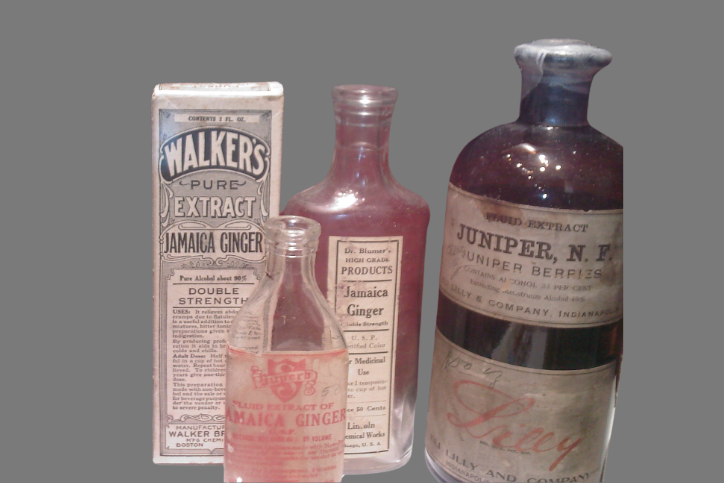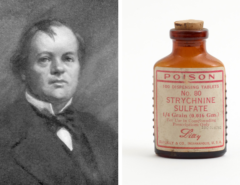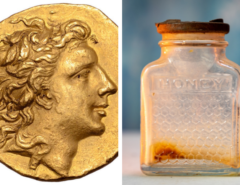The ratification (official change) of the 18th amendment of the United States (US) Constitution in 1919 prohibited the manufacture, sale, or transportation of intoxicating liquors. This amendment, along with the Volstead Act, worked to limit drinking alcohol within the US. Although Prohibition (1920-1933) was known for speakeasies, gangsters, bathtub gin, and moonshine, it also brought about a distinct and terrible illness. This illness went by many names, such as the “jake walk,” “jake leg,” “jakeitus,” “jakeralysis,” and “gingerfoot.” It was so prevalent and tragic that it was featured in a variety of songs from that time, including the famous blues musician Ishmon Bracey’s “Jake Liquor Blues,” and the Mississippi Sheiks’ “Jake Leg Blues.”
Jake walk was caused by drinking contaminated Jamaica ginger extract – “jake.” Jake walk earned its name from the unusual manner of walking people eventually acquired after drinking the jake. Ginger jake was a popular alternative to alcohol during Prohibition. It was an alcoholic extract of ginger root used for years prior to Prohibition. It was used both as a beverage and as a proprietary medicine (chemicals used for medicinal purposes). Ginger jake preparations were an average of 80 percent alcohol (160 proof).
After the start of Prohibition, the government restricted the distribution of ginger jake products because they did not conform to regulations. The government required a certain amount of bitter ginger solids (at least five grams per cubic centimeter of alcohol) to be present in the medicinal ginger extract to make it less drinkable because of the taste. Government inspectors tested medicinal preparations by boiling off the alcohol and weighing out the remaining ginger solids to see if they met their standards. Manufacturers often added other substances to their preparations to get around these government restrictions and audits because these other substances would not evaporate like alcohol but did not taste as bad. The added substances included molasses and castor oil. Another additive was plasticizers such as Lindol. This plasticizer (a chemical used to keep synthetic materials, such as film, from becoming brittle) contained a chemical called triorthocresyl phosphate (TOCP). Harry Gross and Max Reisman, nicknamed “the Killer Chemists of Prohibition,” were manufacturers out of Boston (Hub Products Co) and were ultimately charged with conspiracy to violate US laws in the shipment of contaminated fluid ginger extract. They were fined and sentenced to two years in prison.
TOCP is the substance that led to jake walk. Batches of contaminated jake were reported to contain anywhere from 0.5 percent to 3 percent TOCP and were being shipped throughout the southern US.
TOCP damages nerve cells in a delayed fashion. Once jake was consumed people may have experienced nausea, vomiting, and diarrhea. Damage to nerve cells would not appear until about 10 to 14 days later, though sometimes it could take longer. These delayed symptoms included muscle pain, muscle cramps, numbness, changes in reflexes, muscle weakness, and paralysis. These symptoms primarily affected the legs, though sometimes the hands and elbows were affected, too. This paralysis could come on quite quickly over the course of a few hours and then spread, becoming worse over time. The arms were usually affected days after the legs. The term “jake walk” describes the unusual walk people had due to the paralysis in their legs. They were forced to swing their lower legs and foot forward (as the foot dangled, like a puppet), slapping them (toe first to the floor, heel second) onto the floor to walk. The leg had to be lifted high to allow the foot to clear the floor. Sadly, there was no treatment or antidote available for this poisoning. While some people saw gradual improvement in their symptoms, others were left permanently disabled.
Numbers vary, but it is estimated that around 50,000 Americans were left paralyzed by jake. Jake walk often affected society’s more vulnerable members – poorer residents that turned to jake and other products for alcohol. This included working class farmers and low-income townsfolk. Wealthier people bought liquor from Canada. In some rural areas, people had access to stills (metal canister that holds liquid). People experiencing jake walk faced discrimination. Some religious groups blamed the disorder on their poor lifestyle choices, saying they had brought the disease upon themselves. They encouraged the public not to pity people with jake walk. Interviews with victims from the 1970s showed how many tried to hide the fact that they had the disease by saying they had a stroke.
The sad accounting of the jake poisoning of the 1930s still has many lessons to teach us today. Then and now we see discrimination against patients in health care and society at large for their struggles (diseases including mental illness, HIV/AIDS, and substance use disorder). There are also many communities within America, like those in the 1930s, that are disadvantaged, isolated, or underserved. These communities may have limited access to many resources, including health care.
Jake walk poisonings are still relevant within the medical community today. Outbreaks continue to occur with both TOCP and chemicals like it. Fortunately, increased regulation has made it less of a risk for the American public. From the 1940s through the 1980s there have been periodic outbreaks across the world of TOCP-contaminated food, flours, and oils. In more recent times, poison centers handle cases of toxicity from organophosphate chemicals in the same family as TOCP. Farmers using select pesticides, and industrial workers and sometimes soldiers may be exposed to organophosphates.
Amber Ferrell, PharmD
Certified Specialist in Poison Information





Leave a Reply